On Tuesday, Lawrence city commissioners conducted public hearings and approved the proposed boundaries for tax incentives requested by the University of Kansas (KU) for its Gateway District project.
These tax breaks are part of KU’s plan to develop the second phase of the district, which will complete the construction of the football stadium and include various other developments.
Key Components of KU’s Gateway District Phase 2
KU’s Gateway District is set to include the following major components in its second phase:
- A football stadium with upgrades and parking facilities
- 1,000 parking spaces (both above and underground)
- A 20,000-square-foot outdoor plaza
- A 162-room hotel
- A 443-bed student housing facility
- 43,000 square feet of retail, office, and restaurant space
Tax Incentive Mechanisms: STAR Bonds and TIF District
The Gateway project is structured to take advantage of two types of tax incentives:
- STAR (Sales Tax and Revenue) bonds: These bonds would allow the sales tax revenue generated within the project area to be used to fund the development.
- TIF (Tax Increment Financing): This financing method utilizes the increase in property tax revenue resulting from the development to fund public improvements.
The total incentives package for the Gateway District is valued at $85.2 million, specifically designated for the stadium and parking improvements. However, the entire Gateway Project is estimated to cost $759 million.
Community Support and Concerns
At the meeting, about 20 community members spoke, with the majority expressing support for the project and the associated tax incentives. However, several voiced concerns about the neighborhood’s impacts and specific details about the project.
District Boundaries and KU’s Contributions
KU Endowment has committed to donating $4 million in land for affordable housing or other city uses, and the university plans to contribute $14.5 million toward stormwater management in the Jayhawk watershed. This contribution was outlined in a nonbinding memorandum of understanding (MOU).
Commissioner Amber Sellers emphasized that KU has not adequately provided housing for its student population, with KU currently leasing apartments in nearby complexes.
KU’s CFO, Jeff DeWitt, noted that the university has legal authority to issue $100 million in bonds for new student housing.
The Gateway District includes plans for a 443-bed student housing facility, with plans for an additional 600-bed residence hall.
Concerns Over Memorandum of Understanding (MOU)
Commissioner Lisa Larsen expressed reservations about the MOU, stating that the language was unclear and not favorable to the city. She stated that going forward, the agreement needed clearer language to define both parties’ obligations.
However, Vice Mayor Brad Finkeldei believed that approving the items on the agenda would not diminish the city’s negotiating power.
Approval of Tax District Boundaries and STAR Bond Project
The commissioners voted 5-0 in favor of an ordinance that established the boundaries for the TIF district and 4-1 in favor of the STAR bond district, with Commissioner Sellers dissenting.
KU’s Community Improvement District (CID)
KU is also seeking approval to establish a Community Improvement District (CID), which would implement an additional 2% sales tax for the next 22 years. This would support the issuance of up to $20.2 million in bonds for the project.
Next Steps for the Gateway Project
The commissioners are expected to review additional steps for the Gateway Project at their upcoming meetings on July 1 and August 5, 2025.
The approval of the tax district boundaries marks a significant milestone for the Gateway District project at the University of Kansas.
While there are some concerns regarding the language of agreements and the overall impact on the community, the project promises to bring significant infrastructure development, including new student housing, a stadium, and a hotel, along with retail spaces.
The next steps in the approval process will be reviewed in future city meetings, which will help to refine and move the project forward.




